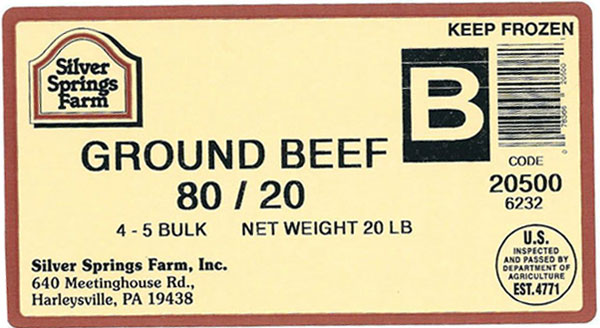
- USDA FSIS announces that Silver Springs Farms recalls ground beef products that may be contaminated with E. coli O157:H7
WASHINGTON, 2016-Oct-04 — /EPR Retail News/ — Silver Springs Farms, Inc., a Harleysville, Pa. establishment is recalling approximately 740 pounds of ground beef products that may be contaminated with E. coli O157:H7, the U.S. Department of Agriculture’s Food Safety and Inspection Service (FSIS) announced today ( Sept. 30, 2016 ).
The ground beef items were produced on August 19, 2016. The following products are subject to recall:
- 20-lb cases containing 4 packages of 5-lb ground beef 80/20.
The products subject to recall bear establishment number “EST. 4771” inside the USDA mark of inspection. These items were shipped to a distributor in Virginia.
The problem was discovered during a routine verification sampling performed by Silver Springs Farms, Inc. There have been no confirmed reports of adverse reactions due to consumption of these products.
E. coli O157:H7 is a potentially deadly bacterium that can cause dehydration, bloody diarrhea and abdominal cramps 2–8 days (3–4 days, on average) after exposure the organism. While most people recover within a week, some develop a type of kidney failure called hemolytic uremic syndrome (HUS). This condition can occur among persons of any age but is most common in children under 5-years old and older adults. It is marked by easy bruising, pallor, and decreased urine output. Persons who experience these symptoms should seek emergency medical care immediately.
FSIS and the company are concerned that some product may be frozen and in consumers’ freezers.
Consumers who have purchased these products are urged not to consume them. These products should be thrown away or returned to the place of purchase.
FSIS routinely conducts recall effectiveness checks to verify recalling firms notify their customers of the recall and that steps are taken to make certain that the product is no longer available to consumers. When available, the retail distribution list(s) will be posted on the FSIS website at www.fsis.usda.gov/recalls.
FSIS advises all consumers to safely prepare their raw meat products, including fresh and frozen, and only consume ground beef that has been cooked to a temperature of160° F. The only way to confirm that ground beef is cooked to a temperature high enough to kill harmful bacteria is to use a food thermometer that measures internal temperature, http://1.usa.gov/1cDxcDQ.
Media and consumers with questions regarding the recall can contact Dan Fillippo, Owner, at (215) 256-4321.
Consumers with food safety questions can “Ask Karen,” the FSIS virtual representative available 24 hours a day at AskKaren.gov or via smartphone at m.askkaren.gov. The toll-free USDA Meat and Poultry Hotline 1-888-MPHotline (1-888-674-6854) is available in English and Spanish and can be reached from 10 a.m. to 4 p.m. (Eastern Time) Monday through Friday. Recorded food safety messages are available 24 hours a day. The online Electronic Consumer Complaint Monitoring System can be accessed 24 hours a day at: http://www.fsis.usda.gov/reportproblem.
| PREPARING PRODUCT FOR SAFE CONSUMPTION USDA Meat and Poultry Hotline 1-888-MPHOTLINE or visit www.fsis.usda.govWash hands with warm, soapy water for at least 20 seconds before and after handling raw meat and poultry. Wash cutting boards, dishes and utensils with hot, soapy water. Immediately clean spills. Keep raw meat, fish and poultry away from other food that will not be cooked. Use separate cutting boards for raw meat, poultry and egg products and cooked foods. Color is NOT a reliable indicator that meat has been cooked to a temperature high enough to kill harmful bacteria. The only way to be sure the meat or poultry is cooked to a high enough temperature to kill harmful bacteria is to use a thermometer to measure the internal temperature.
Refrigerate raw meat and poultry within two hours after purchase or one hour if temperatures exceed 90º F. Refrigerate cooked meat and poultry within two hours after cooking. |
| USDA Recall Classifications | ||
| Class I | This is a health hazard situation where there is a reasonable probability that the use of the product will cause serious, adverse health consequences or death. | |
| Class II | This is a health hazard situation where there is a remote probability of adverse health consequences from the use of the product. | |
| Class III | This is a situation where the use of the product will not cause adverse health consequences. | |
Contact:
Congressional and Public Affairs
Allie Ryan
(202) 720-9113
Press@fsis.usda.gov
Source: USDA
###